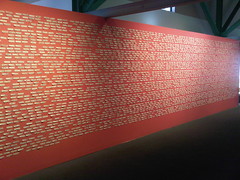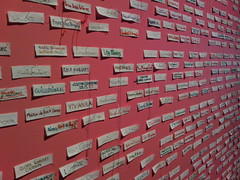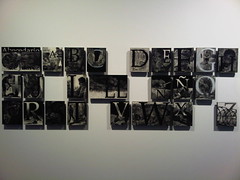
If you have visited Leonard Pearlstein Gallery at Drexel University in the past, forget all previous knowledge. No longer ensconced in the limiting compartment off of Nesbitt Hall’s lobby, Ni Una Mas inaugurates a new and expansive gallery space, used effectively in the current offering and brimming with potential for future exhibitions. It is a somber yet worthy debut for the building, located on Filbert Street between 36th and 34th Streets, considering the emotional and thematic heft of Ni Una Mas (Not One More), which draws upon the holocaust of young women in Ciudad Juárez, Mexico.
Some of the artwork deals directly with the murders, while other pieces are more nuanced in approach or were even created years before the current crisis began. Taken as a whole, the exhibition is ambitious in size, gathering a combination of twenty artists, a number of whom are bona fide blue chip titans of the international art world, and placing them alongside artists of emerging and lesser-known mid-career status. The mixing of these artists could have been a terrible albatross, where the celebrities suck all the air out of the room. But the combination is seamless, with all the pieces working in concert to amplify the cause that Ni Una Mas underlines.
The contributions of Frank Bender are a fascinating example of the exhibition’s thematic power. He is a self-taught forensic facial reconstruction expert who has worked on numerous high-profile cases and has bootstrapped himself into something of an outsider artist slash social crusader. Bridging a crossroads between art, science, and crime scene investigation, his work, already imbued with a healthy dose of altruism, is elevated here by context and proximity.






Ticking off the big names, there is a Kiki Smith lithograph as well as several Nancy Spero works on the torture of women (the two, kindred spirits in a way). They are decent, if unremarkable examples from two eminent artists with formidable bodies of work. Nevertheless, their presence helps if for nothing else than to lend credibility and a roundness to the exhibition.






Then there is Yoko Ono’s Heal, a new work contributed especially for Ni Una Mas. Consisting of a slashed sheet of canvas, viewers are invited to mend the cuts with provided needles, thread, and fabric for patches. She allows for participants’ creativity to flow freely in the stitching, depending on their interaction for the ongoing completion of the work. In this way, it also becomes a performance piece. The silhouette from the back, as many hands work upon it, is elegiacally poetic.





I am most definitely a fan of Margarita Cabrera, who is represented here by four of her soft vinyl sculptures, all objects of domestic servitude, the role that employs so many female Mexican immigrants in the United States. Is she the inheritor to Claes Oldenburg? Scale, social context, and era have everything to do with how she is different.




Emerging artist Andrea Marshall had to be my favorite, offering a series of photo works and a painting. Yes, this is another female artist who uses identity-skewing role play in self-portraits to comment on the way women are perceived and treated by men. But there is a certain energy which makes her work different. Though the influences are obvious (Kahlo, Dali, Man Ray, Warhol, Cindy Sherman, et al.) she uses them judiciously, blending with tact and extrapolating something that feels new-ish. This is not a backhanded compliment; she exemplifies Millennials, and our penchant for mash-up and remix, done right.





Lise Bjørne Linnert, who performed at the beginning of ARTMARCH for Juárez (clip here), has created something akin to a war memorial for the femicide victims. Thousands of names, all uniquely hand-embroidered onto strips of cloth tape, are mounted across a pink wall. Their spacing holds a hidden meaning, using Morse code spelling to write out the American and Mexican national anthems. The title Desconocida, Unknown, Ukjent seems at least partly a misnomer, as it enshrines the names of the victims unless their identities are truly unknown. Regrettably, the work is ongoing due to the ever rising total of dead; it is staggering to be confronted with the sheer range of casualties.



Away from the main gallery, down a corridor, and past the restrooms is Teresa Serrano’s gripping, though profoundly unsettling video La Piñata, wherein a man demolishes a girl-shaped piñata with exponentially increasing aggression. He begins by pacing around the effigy with menacing intent, first caressing her with his staff. Then he begins to swing, sometimes making contact and breaking off a limb, sometimes swinging so violently that he misses. He continues until her head is all that dangles from the wire, before finally bashing it to the ground. The installation of the work is a stroke of genius: viewers stand in a darkened room and look through a large pane of glass into the adjacent room where the video is projected onto a wall. Whether this setup was intentional or a happy accident of necessity is a mystery, but I will give the benefit of the doubt. Its effect is like that of looking through a two-way mirror, evoking the atmosphere of a police station interrogation room or, more appropriately with this work, an execution chamber.



I kept looking at these Brian Maguire paintings; I’m not sure of what they are beyond a Jenny Saville rip-off.

There is far too much art for me to continue to dissect individually, and the greater part of it is excellent; further examples are posted below and at my Flickr photoset of the exhibition.
Ni Una Mas is a powerfully poignant journey; I noted one viewer standing outside the gallery overcome with emotion. It dares to shock, enthrall, evoke outrage, promote healing, and argue the case for why it all matters, never once turning preachy. There is also beauty nestled among the depictions of moral decay. It demands nothing less than one’s undivided attention and commands that the viewer be not only made aware of the Juárez murders, but also want to advocate for their end.












No comments:
Post a Comment